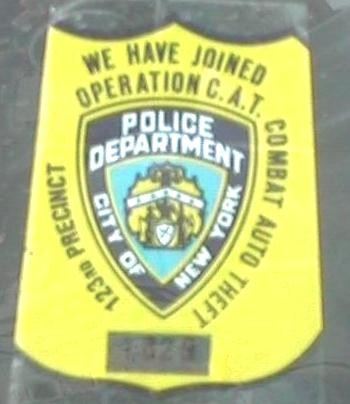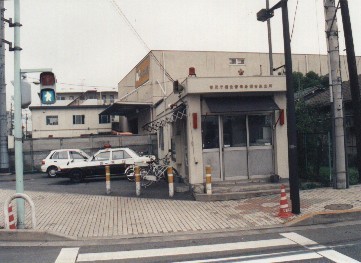
COMMUNITY ORIENTED POLICING
Components:
1. Decentralization (command-decision making)
2. Permanent beat assignments
3. Daily face to face contact with citizens
4. Foot patrol (depending on type of community)
5. Problem solving-underlying dynamics
6. Creativity-Sticker in window to deter car thefts

7. Enable communities to solve own problems-
8. Priority reassessment
9. Address Crime, Fear of Crime, Disorder and Quality of life issues
10. CPO - new breed

Koban outside of Tokyo, Japan
11. Sharing power-volunteers, soliciting input- etc.
12. Developing Trust-Media-inquiries
13. Philosophy-partnership
Difficulties with Community Policing
1. Expensive
2. Lack of evaluation -before-after
3. Lack of definition-understanding of what (CP) it is
(foot patrol, title, crime prevention etc)
4. Resistance to change-mid level officers
5. Resistance to change-patrol officers
6. Definition of community- if no community-cannot create one
7. Willingness of community residents to participate-Gates comment
8. Not implemented department wide-(COP officers perceived as smile and wave officers)
9. Commitment and support by politicans may wane-not quick fix
10. Lack of direct supervision-potential for abuse
11. LE Agency fragmentation
12. Friction/animosity between LE agencies
13. Additional training Required-For CPO and supervisors
14. Training for politicians?
15. Human relations training limited in basic
training/academy
15. New breed-With old material- values of subculture/attitudes
which exist
For more links to information on community policing click here
Important Concepts/Information, lectures 1-3:
![]() Each of the three components of the CJ system affect each other.
Each of the three components of the CJ system affect each other.
![]() Agencies within a component, i.e. courts, police or corrections, affect each
other.
Agencies within a component, i.e. courts, police or corrections, affect each
other.
![]() It is important to study all three components since they all affect each other
It is important to study all three components since they all affect each other
![]() It is important to study all three components since all can experience similar
problems.
It is important to study all three components since all can experience similar
problems.
![]() Individual goals and objectives of in
each component may conflict with those of other components.
Individual goals and objectives of in
each component may conflict with those of other components.
![]() There can be no mission for the entire C.J. system since no one is in charge
of it.
There can be no mission for the entire C.J. system since no one is in charge
of it.
![]() Policing in the United States is highly fragmented with more than separate 18,000
agencies
Policing in the United States is highly fragmented with more than separate 18,000
agencies
![]() The goals of one C.J. component may conflict with those of another
The goals of one C.J. component may conflict with those of another
![]() Uniformity among all law enforcement agencies, corrections, and the courts is
not possible
Uniformity among all law enforcement agencies, corrections, and the courts is
not possible
![]() Funding sources differ for most agencies, hence differences in operation, effectiveness,
goals, etc.
Funding sources differ for most agencies, hence differences in operation, effectiveness,
goals, etc.
![]() Some Public Sector jobs can have benefits and rewards similar to private sector
jobs
Some Public Sector jobs can have benefits and rewards similar to private sector
jobs
![]() Some Public Sector jobs simply are not intrinsically rewarding
Some Public Sector jobs simply are not intrinsically rewarding
![]() Our C.J. System is not much of a system
Our C.J. System is not much of a system
![]() There are six crucial elements to a bureaucracy, according to Max Weber
There are six crucial elements to a bureaucracy, according to Max Weber
![]() A bureaucratic structure provides stability and continuity
even as leaders change
A bureaucratic structure provides stability and continuity
even as leaders change
![]() The level of bureaucracy may differ depending on the type and nature of an organization
The level of bureaucracy may differ depending on the type and nature of an organization
![]() Management is following and applying rules
Management is following and applying rules
![]() Leadership is breaking them and making new ones
Leadership is breaking them and making new ones
![]() Leaders may become ineffective if they have a strong need to be liked
Leaders may become ineffective if they have a strong need to be liked
![]() Leaders have great difficult disciplining those they care for
Leaders have great difficult disciplining those they care for
![]() Rule based on fear is more stable/better than rule based on love of the leader
Rule based on fear is more stable/better than rule based on love of the leader
![]() Scientific Management Theory used science/math to assess what a worker should
do and how
Scientific Management Theory used science/math to assess what a worker should
do and how
![]() Under S.M.T. all workers are naturally lazy
Under S.M.T. all workers are naturally lazy
![]() Under S.M.T. workers can be motivated by money
Under S.M.T. workers can be motivated by money
![]() Under S.M.T. Management should only involve itself in routine decision making
Under S.M.T. Management should only involve itself in routine decision making
![]() Under S.M.T. it is not possible to determine how much someone can really work.
Under S.M.T. it is not possible to determine how much someone can really work.
![]() Under Maslow's Hierarchy of Needs, workers can be motivated by satisfying those
needs
Under Maslow's Hierarchy of Needs, workers can be motivated by satisfying those
needs
![]() It is not possible to satisfy all five needs in every organization
It is not possible to satisfy all five needs in every organization
![]() Managers make different assumptions about their workers, which affects their
leadership style
Managers make different assumptions about their workers, which affects their
leadership style
![]() Most managers believe their workers do not like to work and must be coerced
or threatend to do their job
Most managers believe their workers do not like to work and must be coerced
or threatend to do their job
![]() Under the Immaturity/Maturity Model of Chris Argyris, unproductive workers are
not lazy, but immature.
Under the Immaturity/Maturity Model of Chris Argyris, unproductive workers are
not lazy, but immature.
![]() An organization can make workers more or less mature.
An organization can make workers more or less mature.
![]() Community
Policing customizes police priorities and responses based on issues unique to
individual neighborhood
Community
Policing customizes police priorities and responses based on issues unique to
individual neighborhood
![]() Organizational changes
required for community policing are expensive and difficult to implement.
Organizational changes
required for community policing are expensive and difficult to implement.